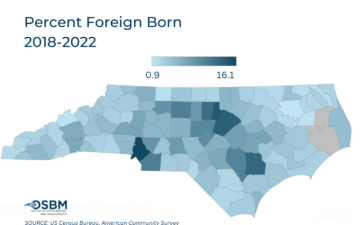North Carolina: Census 2020 Real-Time Response Rates – Week ending May 17 (.pdf)
View All County-Level Response Rates –
Week ending May 17
Key takeaways for week ending May 17
- North Carolina rose one ranking to 34 out of 50 states and DC. With a response rate of 55.7% of households, this is North Carolina’s highest ranking since reporting began in March.
- North Carolina lags national response rate due to lower online responses. North Carolina’s current response rate is 3.8 percentage points below the national average. This gap is entirely driven by lower online response in North Carolina (44.1%) versus the nation (48.1%).
- Five southeastern states now outrank North Carolina. North Carolina has passed three southeastern states in self-response ranking since reporting began – Arkansas, Mississippi, and now Georgia. Five remaining southeastern states outrank NC – Virginia (64.6%), Kentucky (63.2%), Tennessee (59.5%), Alabama (57.6%), and Florida (57.0%).
- Three counties now exceed North Carolina’s 2010 state self-response rate (64.8%). These are: Union County (67.4%), Orange County (65.7%), and Wake County (64.9%). This is up from one county last week.
- Response rate gap continues to grow between the state and tracts with smallest share of young children. The gap between the state response rate and the average rate for tracts with a population of <4.1% children has widened each week since the start of reporting. The disparity is now 2.3 percentage points: 53.4% of households in tracts with the fewest young children vs. 55.7% of households statewide.
- Tracts with the smallest share of foreign-born residents continue to close response rate gap with state. Two weeks ago, the response rate gap between the state and tracts with less than 2.9% foreign-born resident reached a peak of 4.2 percentage points. It has since decreased to 4 percentage points: 51.7% for households in these tracts vs. 55.7% of households statewide.
- Less than half of households where >50% of residents are non-white have responded to the Census. On average, 48.9% of households have responded to the 2020 Census in majority minority tracts, below the state average by 6.8 percentage points.
- Largest gaps in response rates align with internet access. Tracts where 31% or more of households lack internet access have the lowest average response rate: 47.5%. This rate is 16.8 percentage points below the average response rate in tracts with the highest internet access: 64.3%.
Last updated: 5.18.20


